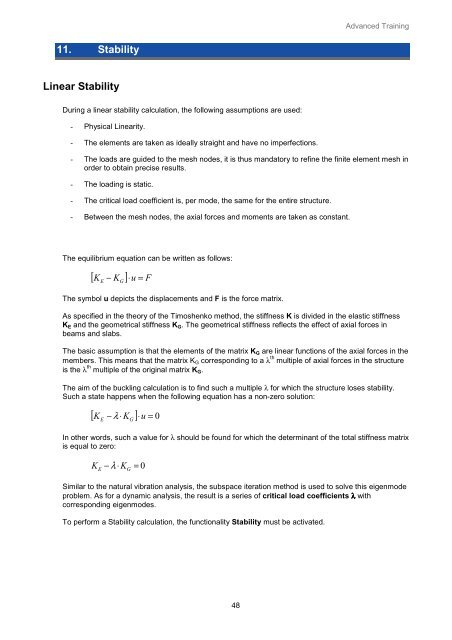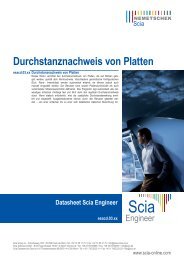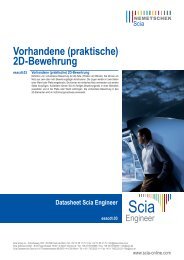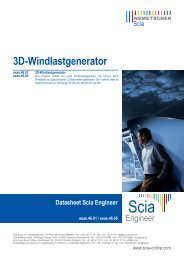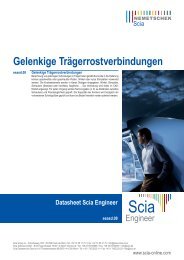Advanced Package Training Scaffolding 2011.1 - Scia-Software GbR
Advanced Package Training Scaffolding 2011.1 - Scia-Software GbR
Advanced Package Training Scaffolding 2011.1 - Scia-Software GbR
You also want an ePaper? Increase the reach of your titles
YUMPU automatically turns print PDFs into web optimized ePapers that Google loves.
11. Stability<br />
Linear Stability<br />
During a linear stability calculation, the following assumptions are used:<br />
- Physical Linearity.<br />
- The elements are taken as ideally straight and have no imperfections.<br />
48<br />
<strong>Advanced</strong> <strong>Training</strong><br />
- The loads are guided to the mesh nodes, it is thus mandatory to refine the finite element mesh in<br />
order to obtain precise results.<br />
- The loading is static.<br />
- The critical load coefficient is, per mode, the same for the entire structure.<br />
- Between the mesh nodes, the axial forces and moments are taken as constant.<br />
The equilibrium equation can be written as follows:<br />
[ − K ] ⋅u<br />
= F<br />
KE G<br />
The symbol u depicts the displacements and F is the force matrix.<br />
As specified in the theory of the Timoshenko method, the stiffness K is divided in the elastic stiffness<br />
KE and the geometrical stiffness KG. The geometrical stiffness reflects the effect of axial forces in<br />
beams and slabs.<br />
The basic assumption is that the elements of the matrix KG are linear functions of the axial forces in the<br />
members. This means that the matrix KG corresponding to a λ th multiple of axial forces in the structure<br />
is the λ th multiple of the original matrix KG.<br />
The aim of the buckling calculation is to find such a multiple λ for which the structure loses stability.<br />
Such a state happens when the following equation has a non-zero solution:<br />
[ − ⋅ K ] ⋅u<br />
= 0<br />
K G<br />
E λ<br />
In other words, such a value for λ should be found for which the determinant of the total stiffness matrix<br />
is equal to zero:<br />
KE − λ ⋅KG<br />
= 0<br />
Similar to the natural vibration analysis, the subspace iteration method is used to solve this eigenmode<br />
problem. As for a dynamic analysis, the result is a series of critical load coefficients λ with<br />
corresponding eigenmodes.<br />
To perform a Stability calculation, the functionality Stability must be activated.


